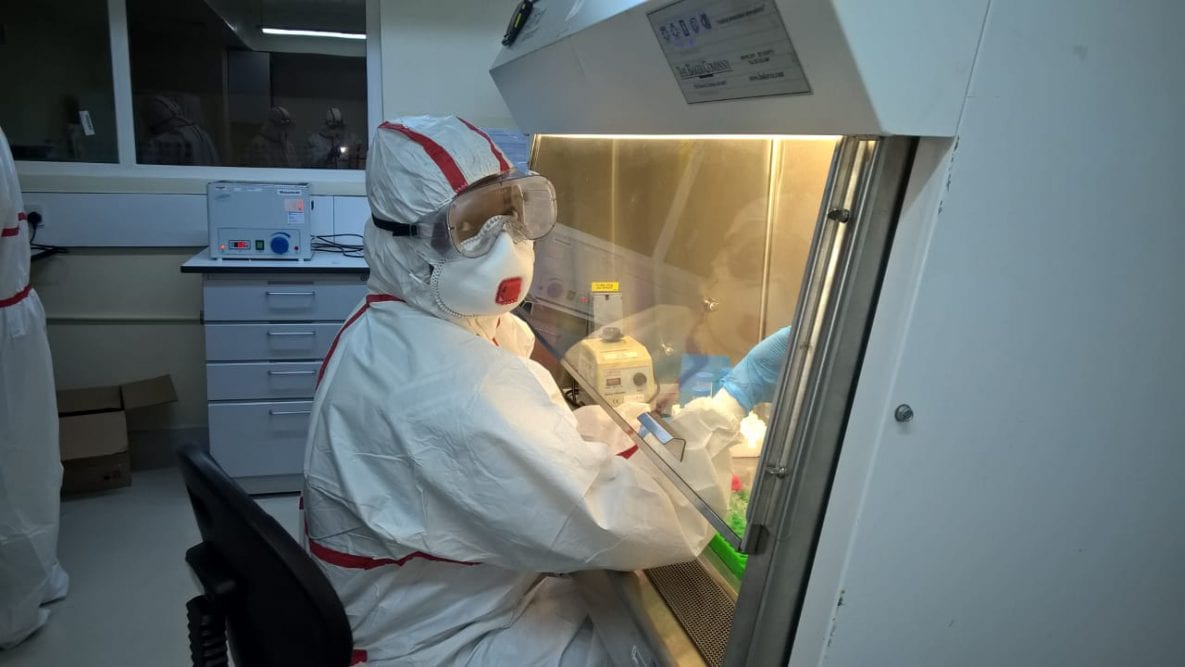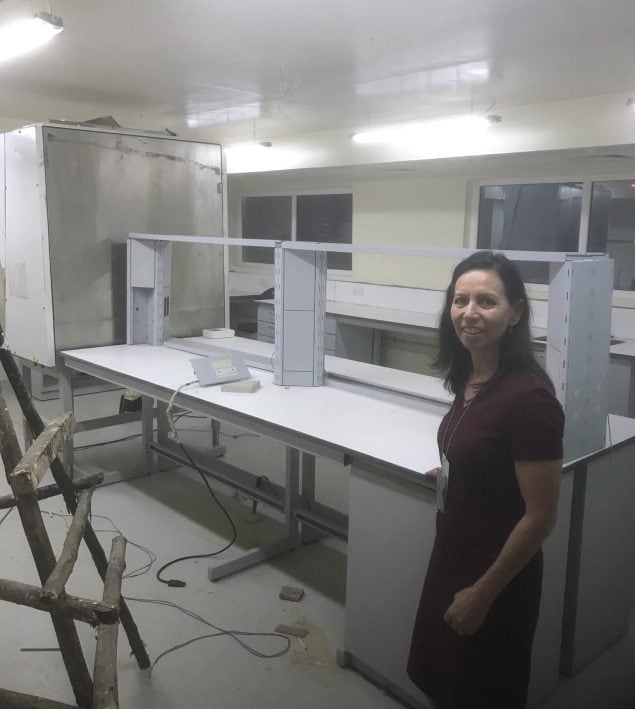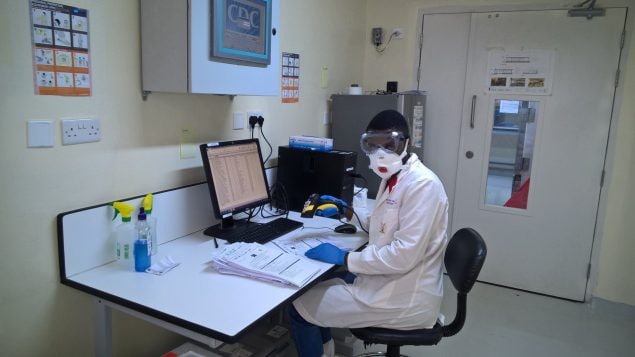Laboratory Renovations Prepare Kenya for COVID-19
September 20, 2021

CDC Kenya laboratory staff, Albina Makio, prepares COVID-19 specimens for testing at the Nairobi laboratory. Photo: Bonventure Juma, CDC Kenya
On March 12, 2020, Kenya detected its first case of COVID-19 after putting laboratories and public health workers on high alert, following the World Health Organization (WHO) declaration of COVID-19 as a Public Health Emergency of International Concern.
For more than 40 years, CDC has helped strengthen public health and laboratory systems in Kenya, creating an integrated research and program center to prepare for disease threats, such as COVID-19. Established by CDC’s Division of Global Health Protection (DGHP) in 2006, the Nairobi laboratory is a Biosafety Level (BSL) 3 laboratory, a distinction used to ensure the protection of laboratory staff, the general public, and the environment from infectious pathogens. During its first 10 years in operation, the laboratory successfully investigated over 190 disease outbreaks in Kenya, and an additional 13 in the African region. Also, the Nairobi laboratory assisted multiple countries in Africa by providing technical training and diagnostic laboratory support for outbreak response.

Elizabeth Hunsperger, Director of CDC Kenya’s diagnostics laboratory program, visits the Nairobi laboratory while under construction, January 2020. Photo: Matt Mikoleit, CDC
Just one month after identifying the first case of COVID-19, CDC Kenya completed a three-year renovation on its Nairobi diagnostics laboratory. The laboratory had closed in June 2016 because it could not maintain the requirements of a BSL-3 laboratory.
The renovation was extensive. According to Dr. Elizabeth Hunsperger, director of CDC Kenya’s diagnostic laboratory program, “The renovations took almost three years due to multiple complications with the equipment. The infrastructure of the building was old, and many of the materials needed for this specialized laboratory were not available.”
Completing the renovations correctly remained a top priority for the Nairobi laboratory team. The laboratory’s management and operations team in Kenya oversaw the completion of the project, coordinating with partners throughout the process. Ensuring that the laboratory could run safely and effectively as a BSL-3 laboratory was necessary to prepare the laboratory team to respond to local and global outbreaks – including the COVID-19 pandemic.
Just weeks before COVID-19 was first detected in Kenya, all equipment was returned to the laboratory from storage as the team prepared to face the novel coronavirus.
From the onset of the COVID-19 outbreak, the laboratory implemented a strategy to test all suspected cases identified by the Kenya Ministry of Health (MoH). “These specimens were received through the MoH and tested in our laboratory,” Hunsperger said.
Working 24 hours a day and seven days a week, the laboratory team successfully tested samples from across the country by leveraging existing CDC Kenya-supported surveillance networks, used to understand the country’s disease burden. These surveillance sites, previously used for acute febrile illness, severe acute respiratory illness, influenza-like illness, and the population-based infectious disease surveillance system, proved to be valuable resources in understanding how the COVID-19 outbreak unfolded in Kenya. Initially, the laboratory focused on testing all suspected cases found through the surveillance network. As the pandemic progressed and cases grew, this expanded to testing samples collected by the government of Kenya from various locations, including mass testing campaigns, truck drivers at all ports of entry, quarantine centers, and international travelers.

CDC Kenya laboratory staff, Tim Mujete, receives COVID-19 specimens to be logged at the Nairobi Photo: Bonventure Juma, CDC Kenya
The Nairobi laboratory opened just in time to significantly support COVID-19 testing in Kenya. By the end of August-2021, the laboratory processed nearly 242,000 COVID-19 specimens. Through the network of CDC Kenya laboratories, including the Nairobi laboratory, CDC supported the systems that performed 45% of all COVID-19 testing in Kenya. In addition, the laboratory team helped train staff, including those from the National Influenza Center and HIV laboratories supported by the President’s Emergency Plan for AIDS Relief (PEPFAR), in all 47 counties on proper biosafety and biosecurity measures, which help protect laboratory staff, the environment, and the general public.
As one of the two laboratories that make up Kenya’s diagnostic laboratory program, the Nairobi laboratory’s response to COVID-19 will prepare the larger network of CDC Kenya-supported laboratories for future disease threats. Laboratory work must not become stagnant, and especially during a growing response, laboratories must retain the highest quality processes to ensure safety and efficiency. “Quality assurance systems need to be established and continually updated throughout the outbreak to ensure high quality results,” Hunsperger said.
The leadership and expertise of the laboratory team, including Hunsperger and Bonventure Juma, deputy director of the diagnostic laboratory program, and the long-established relationship with the Kenya MoH, helped the Nairobi laboratory and its dedicated staff to respond to the COVID-19 outbreak. As COVID-19 continues to impact populations across the globe, recognizing and building upon CDC’s successes, such as the increased laboratory capacity in Kenya, will contribute to overcoming COVID-19 and future disease threats.